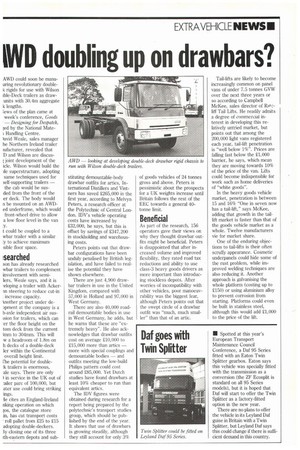ND doubling up on drawbars?
Page 11

If you've noticed an error in this article please click here to report it so we can fix it.
AWE) could soon be manuuring revolutionary doublerigids for use with Wilson ible-Deck trailers as drawunits with 30.4m aggregate k lengths.
lews of the plan came at week's conference, Goods — Designing for Despatch, ;ed by the National Mate; Handling Centre.
)avid Weale, sales manager he Northern Ireland trailer lufacturer, revealed that D and Wilson are discus; joint development of the icle. Wilson would build the )1e superstructure, adopting same techniques used for self-supporting trailers — the cab would be susded from the front of the er deck. The body would n be mounted on an AWDed underframe, which would front-wheel drive to allow a low floor level in the van [y.
t could be coupled to a wbar trailer with a similar Ly to achieve maximum sible floor space.
searched
son has already researched wbar trailers to complement involvement with semilers, Weale says, and it is 'eloping a trailer with Ackeran steering to reduce cut-in increase capacity.
Wother project under deDpment at the company is a b-axle independent air susision for trailers, which can 'er the floor height on the tom deck from the current kinn to 304mm. This will w a headroom of 1.8m on h decks of a double-deck ler within the Continental overall height limit.
[he potential for double • k trailers is enormous, ale says. There are only ) in service in the UK out of :ailer pare of 100,000, but ater use could bring striking ings.
-le cites an England-Ireland nking operation on which i;os, the catalogue store in, has cut transport costs • roll pallet from 225 to E15 adopting double-deckers. 3y closing one of its three 1th-eastern depots and sub stituting demountable-body drawbar outfits for artics, International Distillers and Vintners has saved £265,000 in the first year, according to Melvyn Peters, a research officer at the Polytechnic of Central London. IDV's vehicle operating costs have increased by £32,000, he says, but this is offset by savings of £347,200 in stockholding and warehousing costs.
Peters points out that drawbar configurations have been unduly penalised by British legislation, and have failed to realise the potential they have shown elsewhere.
There are just 4,900 drawbar trailers in use in the United Kingdom, compared with 57,000 in Holland and 97,000 in West Germany.
There are also 40,000 roadrail demountable bodies in use in West Germany, he adds, but he warns that these are "extremely heavy". He also acknowledges that drawbar outfits cost on average 210,000 to £15,000 more than artics — more with special couplings and demountable bodies — and outfits meeting the low-build Philips pattern could cost around 285,000. Yet Dutch studies have found drawbars at least 10% cheaper to run than equivalent artics.
The IDV figures were obtained during research for a report being prepared by the polytechnic's transport studies group, which should be published by the end of the year. It shows that use of drawbars is growing steadily, although they still account for only 3% of goods vehicles of 24 tonnes gross and above. Peters is pessimistic about the prospects for a UK weights increase until Britain follows the rest of the EEC towards a general 40tonne limit.
Beneficial
As part of the research, 156 operators gave their views on why they thought drawbar outfits might be beneficial. Peters is disappointed that after increased volume and improved flexibility, they rated road tax reductions and ability to use class-3 heavy goods drivers as more important than introducing stockless depots, After worries of incompatibility with other vehicles, poor manoeuvrability was the biggest fear, although Peters points out that the swept circle of a drawbar outfit was "much, much smaller" than that of an artic. Tail-lifts are likely to become increasingly common on panel vans of under 7.5 tonnes GVW over the next three years or so according to Campbell McKee, sales director of Ralf:lift Tail Lifts. He readily admits a degree of commercial interest in developing this relatively untried market, but points out that among the 200,000 light vans registered each year, tail-lift penetration is "well below 1%". Prices are falling fast below the £1,000 barrier, he says, which mean they are moving towards 10% of the price of the van. Lifts could become indispensible for work such as home deliveries of "white goods".
In the heavy goods vehicle market, penetration is between 15 and 16% "One in seven now has a tail-lift," says McKee, adding that growth in the taillift market is faster than that of the goods vehicle market as a whole. Twelve manufacturers vie for market share.
One of the enduring objections to tail-lifts is their often scruffy appearance. Cosmetic underpanels could hide some of the rust problem, while improved welding techniques are also reducing it, Another approach is galvanising the whole platform (costing up to £150) or using aluminium alloy to prevent corrosion from starting. Platforms could even be built in stainless steel, although this would add 21,000 to the price of the lift.


























































